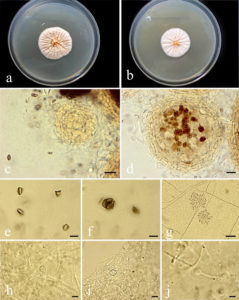Emericellopsis persica Papizadeh, Wijayaw, Soudi & K.D. Hyde, sp. nov., Index Fungorum number: IF552358
Etymology: Epithet taken from its isolation from Iran (formerly known as Persia).
Isolated from soil from lake. Sexual morph Ascomata dark brown, superficial on the substrate, globose, 280–320 μm diam., non-ostiolate. Peridium 19–25 μm thick, multi-layered, pseudoparenchymatous, composed of 3–5 layers of compressed cells. Asci saccate, 15–18 μm diam., with thin deliquescent wall, soon dissolving, unitunicate, scattered irregularly in the ascocarp. Ascospores ellipsoid, pale brown, with uneven surfaces, 8–11 9 4–5 μm (x = 9.5 9 4.5), surrounded by 3 longitudinal, hyaline, sharp appendages, width up to 1 μm. Asexual morph hyphomycetous, acremonium-like. Conidiophores mostly simple orthotropic. Conidiogenous cells 30–40 μm long, phialidic, tapering from 2–2.5 μm at the base to 0.5–0.7 μm at the apex. Conidia narrowly ellipsoid, moothsurfaced, 4.5–6.5 x 2 μm (x = 5.5 x 2), hyaline, adhering in slimy heads. Chlamydospores mostly intercalary, 10–22 9 7–17 μm, hyaline. Culture characteristics: Colonies on CYA agar fastgrowing, reaching 21–23 mm diam. in 7 days at 25 °C. On MEA (pH 6.5) growing slower, reaching 17–18 mm diam. in 7 days. Colonies orange-salmon-pink, later darkening in centre due to the formation of ascomata with tufted aerial mycelium. Reverse colourless. Exudate
absent. Decumbent vegetative hyphae thin-walled, hyaline, 0.5–1.5 μm wide. Mycelium consisting of hyaline, smooth-walled, septate hyphae, 1–2 μm wide, often fasciculate.
Material examined: IRAN, Lake Urmia, soil, 2011, M. Papizadeh, M.R. Soudi (IBRC-H 2022, holotype), ex-type culture IBRC-M 30046. Sequence: ITS sequence GenBank KX668543. The aligned dataset used in the analysis has been submitted with the TreeBase under the submission ID 19688 for the combined set of ITS and b-tub.
Notes: In our phylogenetic analyses, Emericellopsis persica clusters as a distinct clade from other species. Emericellopsis donezkii and E. humicola are the closest species, but separated with high bootstrap support (100 %). Hence, we introduce our strain as a new species based on DNA sequence analyses.
Fig. Emericellopsis persica (holotype). a, b Colonies on CYA and MEA. c, d Immature and mature ascomata. e Ascospores. f Asci. g Acremonium-like conidiophores bearing hyaline conidia. h–j Chlamydospores. Scale bars c–j = 10 μm.

